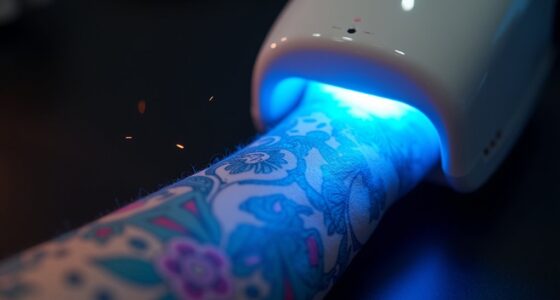To choose the right energy level on your at-home laser device, start with a low setting to guarantee comfort and safety. Assess your skin tone and hair color to determine the appropriate intensity, increasing gradually as your skin adapts. Continuously monitor your skin’s response, looking for any signs of irritation or discomfort, and adjust settings accordingly. Following manufacturer guidelines can help, and if you want to learn more about optimizing your treatment, keep exploring.
Key Takeaways
- Start with the lowest energy setting to assess skin response and comfort before increasing gradually.
- Adjust energy levels based on your skin tone, hair color, and sensitivity to prevent burns or irritation.
- Monitor skin reactions such as redness or discomfort, and reduce settings if adverse effects occur.
- Follow manufacturer guidelines for recommended energy ranges tailored to your device and treatment area.
- Consult professional advice if unsure about appropriate energy levels, especially for sensitive skin or unique conditions.
Understanding Your Laser Device’s Settings
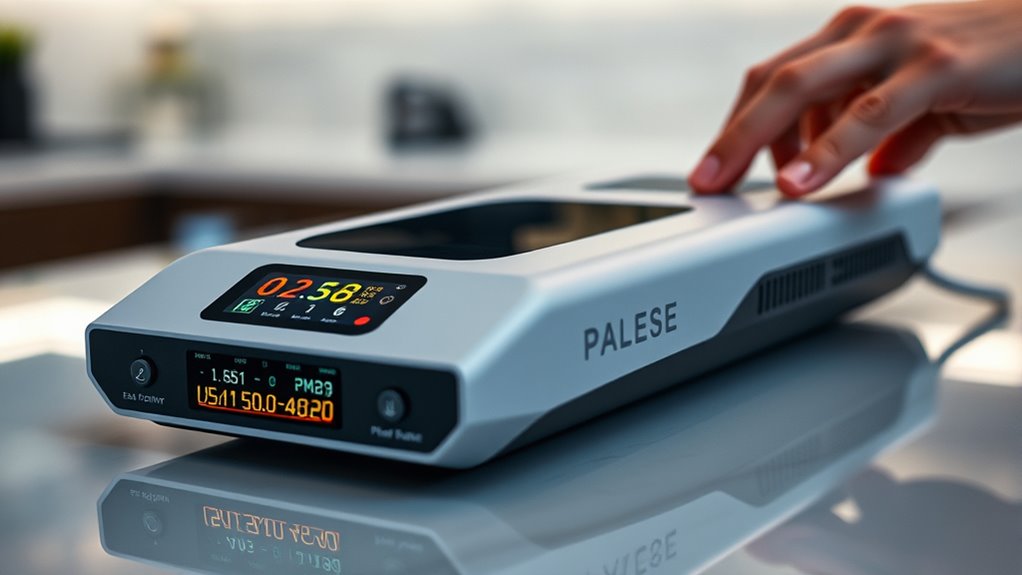
Understanding your laser device’s settings is essential for safe and effective use. Before starting, familiarize yourself with the device’s manual, focusing on laser safety guidelines and recommended calibration procedures. Proper device calibration ensures the laser emits the correct energy level, reducing risks like burns or ineffective treatments. Always check that your device is calibrated according to the manufacturer’s instructions before each use. Adjusting the settings without understanding their impact can lead to unsafe outcomes or subpar results. Pay attention to the intensity levels, pulse duration, and treatment area size. Knowing how to navigate these settings allows you to customize treatments safely, minimizing potential hazards. Remember, understanding your device’s settings is the foundation for safe laser use and ideal results.
Assessing Your Skin Type and Hair Color
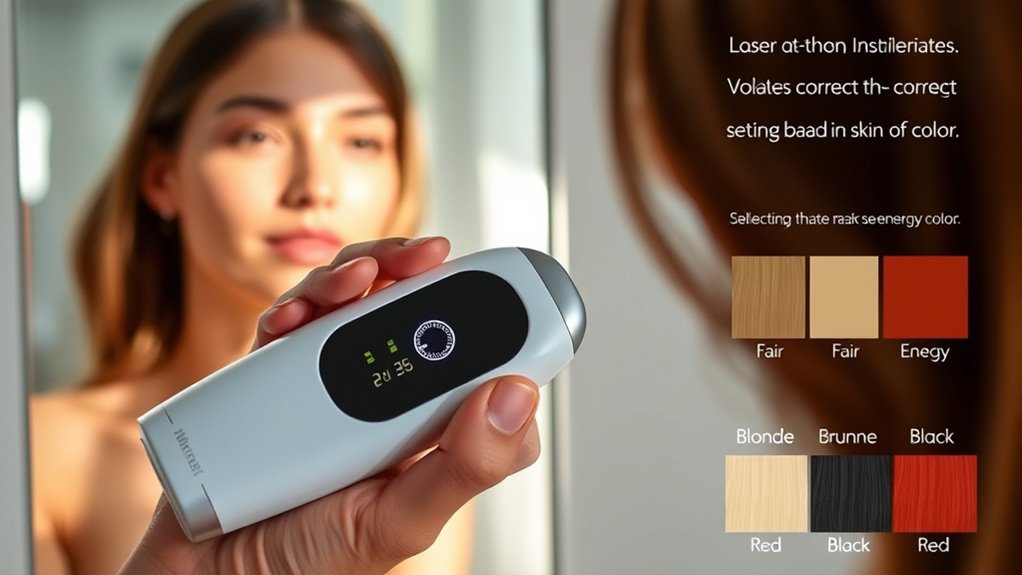
To choose the right energy level on your laser device, you first need to accurately assess your skin type and hair color. Your skin tone plays a vital role; lighter skin tones typically respond better to higher energy levels, while darker tones require gentler settings to avoid burns. Hair pigmentation also matters—darker hair contains more melanin, making it more receptive to laser treatments, whereas lighter or blond hair may need lower energy levels for effective results. Take note of your skin’s hue and how much melanin it contains, along with your hair’s color intensity. Additionally, understanding headphone compatibility can help ensure your device settings are appropriate for your personal needs. This assessment helps you select a safe, effective energy level tailored to your unique characteristics, reducing the risk of side effects and ensuring ideal hair removal results.
Starting With a Low Energy Level
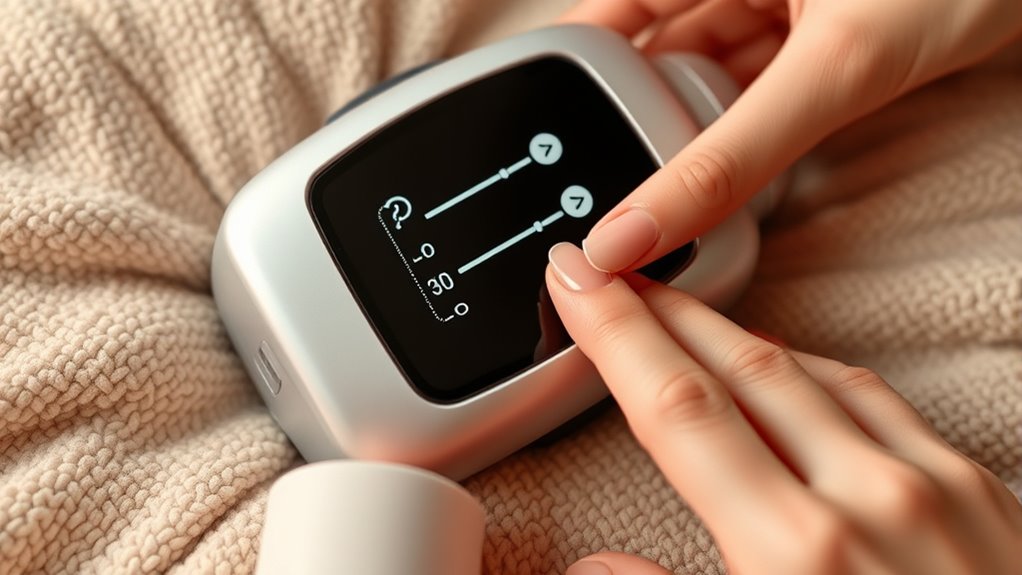
Starting with a low energy level helps guarantee your comfort and safety during treatment. It allows your skin to gradually adapt to the laser, reducing the risk of adverse reactions. By beginning softly, you set the foundation for effective results without unnecessary discomfort. Additionally, understanding your energy level options and how they impact your treatment can help you make informed decisions for optimal outcomes.
Ensuring Safe Sensation
Because your skin can react differently to laser treatments, it’s essential to begin with a low energy level to guarantee a safe sensation. Starting low helps you assess your comfort and prevents unnecessary pain or discomfort. Pay attention to how your skin responds, and adjust accordingly for effective pain management. Remember, maintaining your device properly—cleaning and checking for damage—ensures consistent performance and reduces skin irritation. If you experience mild discomfort, pause and reevaluate your settings before continuing. Never push past a painful sensation, as this can cause skin damage. Taking these precautions helps you stay safe, comfortable, and confident during your at-home laser treatments. Always prioritize safe sensation over speed to achieve the best results without risking your skin’s health. Monitoring your device’s performance and understanding proper maintenance can also help prevent adverse reactions.
Gradual Skin Adaptation
Since your skin needs time to adjust to laser treatments, beginning with a low energy level is essential for gradual adaptation. Starting slowly helps your skin build tolerance, reducing the risk of irritation caused by increased skin sensitivity. By using a lower setting initially, you can monitor how your skin responds and prevent adverse reactions. It’s important to space out treatments appropriately, allowing your skin to recover and adapt without overloading it. As your skin becomes less sensitive over time, you can gradually increase the energy level to enhance effectiveness. This approach ensures safer, more comfortable sessions and helps maintain consistent treatment frequency, which is crucial for ideal results. Patience and gradual adjustment are key to a successful at-home laser routine. Understanding skin sensitivity and how your skin responds can significantly improve your treatment outcomes.
Monitoring Skin Response During Treatment
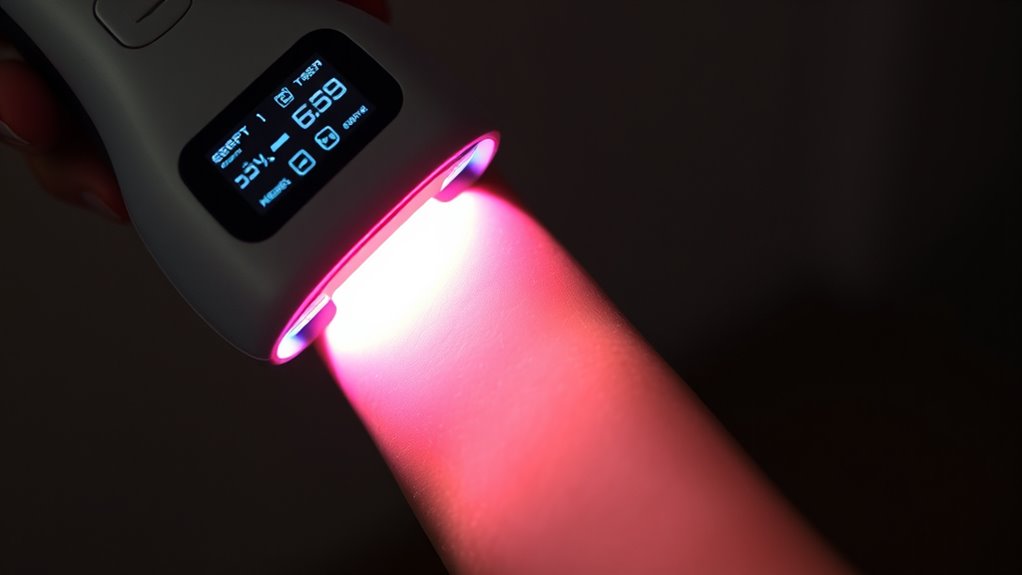
Monitoring the skin’s response during laser treatment is essential to guarantee safety and achieve ideal results. Keep an eye on skin redness, which can indicate how your skin is reacting to the energy level. If redness becomes excessive, it’s a sign to pause or reduce the intensity. Sensation monitoring is equally important—pay attention to any discomfort or unusual feelings, as these can signal that the energy might be too high. Staying aware of these cues helps you adjust in real-time, preventing potential adverse effects. Remember, everyone’s skin responds differently, so consistent observation guides you toward the most effective and safe treatment. By actively monitoring skin redness and sensations, you ensure a controlled, comfortable experience that maximizes benefits. Additionally, understanding how proper treatment settings influence skin response can help you achieve better results while minimizing risks.
Adjusting Settings Based on Comfort and Effectiveness
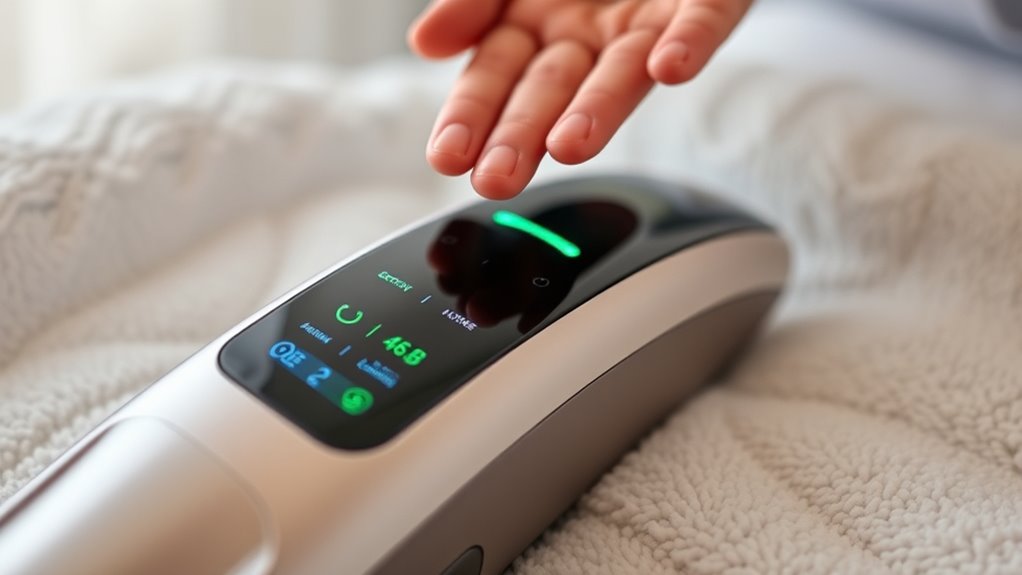
Adjusting your laser device’s settings based on comfort and effectiveness is essential for achieving peak results while guaranteeing safety. Proper device calibration ensures the energy level matches your skin’s needs, preventing over- or under-treatment. Start with a lower power adjustment and gradually increase until you find a comfortable yet effective setting. Pay attention to how your skin responds during each session, adjusting as needed. Visualize these adjustments:
Adjust laser settings gradually for safe, effective results tailored to your skin’s response.
- Fine-tuning the device calibration for optimal performance
- Increasing power gently for better results
- Dialing down if you feel discomfort or irritation
- Monitoring skin reactions after each session
- Ensuring settings are consistent across treatment areas
- Recognizing fandom’s past and present influences how users perceive and adapt to new technology
Recognizing Signs of Overuse or Skin Irritation

It’s vital to recognize the early signs of overuse or skin irritation during laser treatments to prevent damage. Pay attention to your skin’s responses, especially changes in skin sensitivity. If you notice increased redness, swelling, or a burning sensation, these are clear signs of irritation. Persistent discomfort or pain indicates you might be pushing your skin too hard. Skin that feels tender or appears inflamed after treatment suggests overuse. It’s essential to listen to your body and stop treatment if you experience these signs of irritation. Overusing the device or selecting too high an energy level can compromise your skin’s health. Being vigilant about skin sensitivity and early signs of irritation helps protect your skin and ensures safer, more effective laser sessions. Additionally, understanding the proper energy level settings for your device can significantly reduce the risk of adverse reactions.
Consulting Manufacturer Guidelines and Recommendations
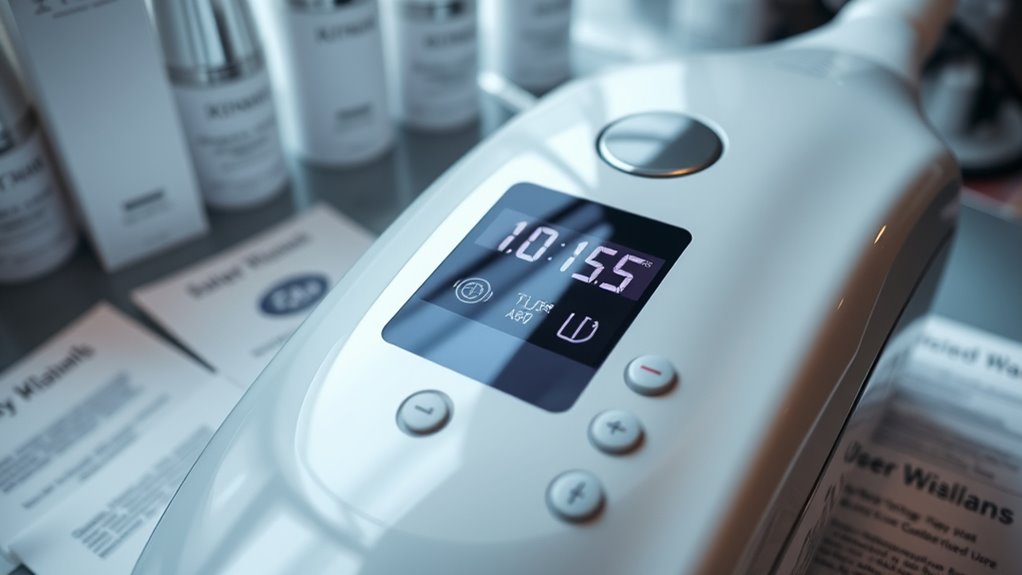
Always read the manufacturer’s instructions carefully before using your laser device. Follow the recommended settings exactly to guarantee safe and effective treatment. Make sure you understand all safety warnings to prevent potential risks. Being aware of privacy and cookie usage can help you make informed decisions about your online safety while researching different device options.
Read Manufacturer Instructions Carefully
Consulting the manufacturer’s guidelines is essential before operating a laser device, as these instructions provide specific safety measures and recommended settings for ideal performance. Carefully reading the manual helps you understand vital aspects like laser safety protocols and proper device calibration. It also guides you on avoiding common mistakes that could compromise safety or damage the device. Keep an eye out for details such as good lighting and proper positioning of the device for best results. Recommended skin contact or distance, adjusting energy levels based on skin type, indicators for device readiness and safety locks, and maintenance and cleaning procedures are also covered.
Follow Recommended Settings Precisely
After thoroughly reviewing the manufacturer’s instructions, you should carefully follow the recommended settings for your laser device. Adhering to these guidelines guarantees ideal laser maintenance, helping your device function efficiently and safely. Using the correct energy level prevents unnecessary strain on the device, which can extend battery life and reduce the need for repairs. Always set the device according to the manufacturer’s specifications, avoiding shortcuts or improvisations. Precise settings also minimize the risk of skin irritation or ineffective treatment. Regularly check for updates or new recommendations from the manufacturer to stay current. Additionally, goal tracking can help you monitor your treatment progress and maintain consistent device settings over time. By following these recommended settings exactly, you protect your investment, maintain device performance, and ensure safe, effective at-home laser treatments.
Understand Device Safety Warnings
Understanding device safety warnings is essential to prevent accidents and guarantee effective treatment. Always consult your manufacturer’s guidelines before use. Pay close attention to warnings about device malfunction, which can cause injury or skin damage. Follow recommended precautions to avoid issues that might void your warranty coverage. Be aware of instructions like:
- Keep the device out of water and moisture
- Never modify or disable safety features
- Use only recommended accessories
- Avoid using if the device shows signs of damage
- Follow charging and storage instructions carefully
These warnings help you operate safely and protect your investment. Ignoring them could lead to device malfunction or invalid warranty coverage, increasing risks and costs. Proper adherence ensures safe, effective treatments every time.
When to Seek Professional Advice
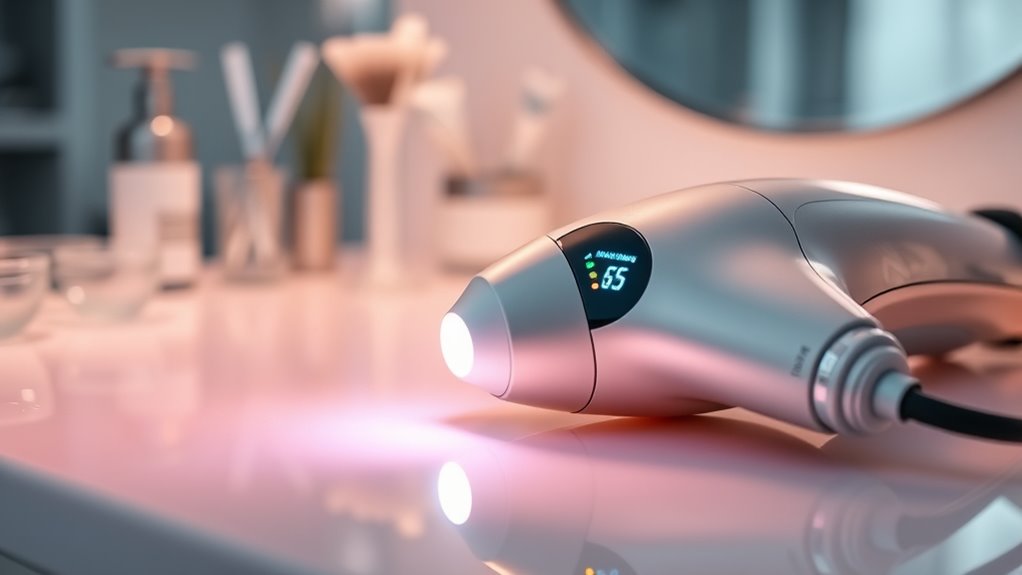
Knowing when to seek professional advice is essential to guarantee safe and effective laser treatments. If you experience any unusual skin sensitivity, persistent redness, or discomfort after using your device, it’s time to consult a professional. A medical consultation can help assess your skin’s condition and determine if laser treatment is suitable for you. This is especially important if you have a history of skin issues, scars, or pigmentation concerns. Don’t ignore signs of adverse reactions or if you’re unsure about your skin’s response to the laser energy. Seeking expert guidance ensures you avoid potential harm and achieve the best results. Remember, professional advice helps tailor your treatment plan and keeps your skin safe throughout the process.
Frequently Asked Questions
Can I Switch Between Different Energy Levels During a Session?
You can switch between different energy levels during a session, but you should do so cautiously. Always consider your device calibration and follow the manufacturer’s instructions to guarantee user safety. Adjusting levels mid-session can be safe if your device allows it and you’re confident in your comfort and response. However, always start at a lower setting and increase gradually to prevent skin irritation or injury.
How Often Should I Change the Energy Level for Optimal Results?
Did you know that adjusting your device’s energy level can boost treatment effectiveness by up to 30%? For ideal results, you should change your energy level gradually, based on your skin’s response and comfort. Always perform an energy level adjustment after device calibration and consider increasing it slightly over sessions. This helps prevent overexposure and ensures safe, effective hair removal, tailored to your progress.
Is There a Risk of Damaging My Skin With High Energy Settings?
Using high energy settings can increase skin sensitivity and the risk of damage if your device isn’t properly calibrated. Always start with lower levels and gradually increase as your skin adapts. Avoid pushing the device beyond recommended settings, and follow manufacturer instructions carefully. If you notice redness or discomfort, reduce the energy level immediately. Proper calibration and listening to your skin’s response help prevent damage and guarantee safe, effective results.
How Do I Know if My Device’S Settings Are Compatible With My Skin?
Imagine your skin as a delicate garden; you want just enough sunlight for growth without scorching. To guarantee your device’s settings suit your skin sensitivity, start with a lower energy level and observe how your skin reacts. Proper device calibration is key—if you notice redness or discomfort, dial back the settings. Always test a small area first, and consult your device instructions to match your skin type safely.
What Are the Long-Term Effects of Using the Device at Various Energy Levels?
You wonder about the long-term effects of using your device at different energy levels. Regular device calibration guarantees safe, effective use, preventing overexposure. Over time, your skin adapts, which might reduce sensitivity or cause irritation if settings are too high. Consistently monitoring your skin’s response and adjusting energy levels helps avoid long-term damage, guaranteeing safe, sustainable results. Always follow manufacturer guidelines for ideal skin health and device performance.
Conclusion
Choosing the right energy level is like tuning a delicate instrument—you want harmony between effectiveness and comfort. By listening to your skin’s whispers and adjusting your settings with care, you’ll master the symphony of at-home laser treatments. Remember, patience and attentiveness are your guiding stars. When in doubt, seek expert advice to guarantee your skincare journey remains a smooth, radiant voyage. Trust your instincts, and let your confidence shine as brightly as your skin.


